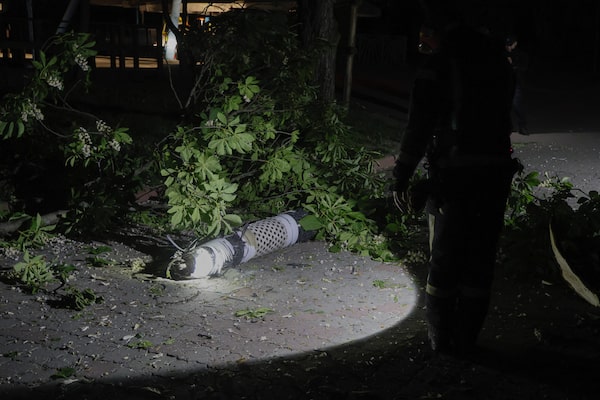Ukraine said on Tuesday it had shot down six Russian Kinzhal missiles in a single night, thwarting a weapon Moscow has touted as a next-generation hypersonic missile that was all but unstoppable.
When asked about the Ukrainian claim, Russian Defence Minister Sergei Shoigu dismissed it, the RIA news agency reported.
The number of claimed Ukrainian missile intercepts in general is “three times greater than the number we launch”, RIA quoted Shoigu as saying.
“And they get the type of missiles wrong all the time. That’s why they don’t hit them,” he said, without elaborating.
It was the first time Ukraine had claimed to have struck an entire volley of multiple Kinzhal missiles, and if confirmed would be a demonstration of the effectiveness of Kyiv’s newly deployed Western air defences.

Police investigate fragments of a Russian rocket that fell in a city zoo in Kyiv after it was shot down by air defense system during the night, May 16, 2023.Alex Babenko/The Associated Press
The United States and the European Union have supplied Ukraine with weaponry to defend itself since Russia invaded in February 2022. EU and NATO member Hungary has refused, however, to provide any military equipment to neighbour Ukraine, and on Tuesday, the government said it had blocked the next tranche of the EU’s off-budget military support known as the European Peace Facility.
Air raid sirens blared across nearly all of Ukraine early on Tuesday and were heard over the Ukrainian capital and the surrounding region for more than three hours.
“A year ago, we were not able to shoot down most of the terrorists’ missiles, especially ballistic ones,” President Volodymyr Zelensky said in praising the military’s claim to the Council of Europe rights body in Iceland by video link.
“And I am asking one thing now. If we are able to do this, is there anything we can’t do?”
The meeting of European leaders over two days was to focus on ways to hold Russia to account for its war, officials said.
Russia says its invasion was necessary to counter threats to its security posed by Ukraine’s growing ties to the West. Kyiv and its allies call it an unprovoked war of conquest. Kyiv says it won’t stop fighting until all Russian forces leave its land.
FLASHES OF LIGHT AND DEBRIS
The six Kinzhals were among 27 missiles Russia fired at Ukraine over the past 24 hours, Ukraine’s military General Staff said in its evening update on Tuesday, lighting up Kyiv with flashes and raining debris after they were blasted from the sky.
It was not clear which Western weapon Ukraine used to defeat the Kinzhals. The Pentagon had no immediate comment.
For its part, Russia’s Defence Ministry claimed to have destroyed a U.S.-built Patriot surface-to-air missile defence system with a Kinzhal missile, the Zvezda military news outlet reported.
But the commander-in-chief of Ukraine’s armed forces, Valeriy Zaluzhnyi, said all had been successfully intercepted.
Kyiv authorities said three people were wounded by falling debris.
“It was exceptional in its density – the maximum number of attack missiles in the shortest period of time,” Serhiy Popko, head of Kyiv’s city military administration, said on Telegram.
Zvezda quoted the Russian ministry as saying the attacks had been aimed at Ukrainian fighting units and ammunition storage sites.
Zaluzhnyi said his forces had intercepted the six Kinzhals launched from aircraft, as well as nine Kalibr cruise missiles from ships in the Black Sea and three Iskanders fired from land.
Two S-300 missiles targeted infrastructure in Kostyantynivka, west of the embattled eastern city of Bakhmut, the General Staff update said.
HYPERSONIC SPEED?
Earlier this month, Ukraine claimed to have shot down a single Kinzhal missile over Kyiv for the first time using a newly deployed U.S. Patriot air defence system.
The U.S. military confirmed that account but did not say whether the Russian missile was flying at hypersonic speed at the time of the intercept.
The U.S.-based Center for Strategic and International Studies (CSIS) says the Kinzhal rapidly accelerates to Mach 4 (4,900 kms/h) after launch and may reach speeds of up to Mach 10 – or 10 times the speed of sound. Hypersonic weapons travel at least five times the speed of sound.
The Kinzhal missile, whose name means dagger, can carry conventional or nuclear warheads up to 2,000 kms. Russia used the weapon in warfare for the first time in Ukraine last year and has only acknowledged firing the missiles on a few occasions.
Russian President Vladimir Putin has frequently touted the Kinzhal as proof of world-beating Russian military hardware, capable of taking on NATO.
With Ukraine set to go on the offensive against Russia’s invasion for the first time in six months, Moscow is launching longer-range air strikes at the highest frequency of the war. Kyiv says it is shooting down most incoming missiles and drones.
This content appears as provided to The Globe by the originating wire service. It has not been edited by Globe staff.